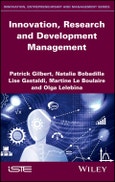In today’s business environment, as organizations constantly seek to growth and develop through the optimization of their innovative and creative potential, understanding the critical issues and management practices in R & D is essential. This book provides a critical revaluation of the state of the art issues and concepts in R&D management. The views expressed are those of leading French researchers and professionals in this field, fed by empirical studies in national and international firms.
Table of Contents
Foreword ix
Acknowledgments xi
General Introduction xiii
Chapter 1. R&D and New Competitive Challenges: Between Intensive Innovation Strategy and Internationalization 1
1.1. Strategy and R&D 1
1.1.1. R&D’s place in business strategies 2
1.1.2. Different generations of R&D 4
1.2. Environmental factors influencing business strategies in R&D and their consequences 9
1.2.1. The major role of innovation in competition strategies 9
1.2.2. The emergence of the consumer in R&D 11
1.2.3. The effects of market globalization 15
1.3. R&D strategies tested overseas: the example of China 21
1.3.1. Western companies’ choice to locate their R&D in China 21
1.4. Conclusion 26
Chapter 2. Work in R&D and its Transformations 29
2.1. Specifics of R&D work and its heterogeneity 29
2.1.1. Non-routine and knowledge intensive work 30
2.1.2. The work in R&D: between interactions and engagements with the surrounding environment 35
2.1.3. A job characterized by a certain degree of autonomy and occupational regulations38
2.2. The main transformations of R&D work since 1990 43
2.2.1. The advent of project management and of the concurrent engineering model 43
2.2.2. A job which is more interactive and more dependent on the downstream 48
2.2.3. Managerialization, bureaucratization and remoteness of technical work 52
2.3. Current tensions and open questions as to the future of work in R&D 56
2.3.1. Increasing pressure and strong focus in the short term: how sustainable is this in individual and collective terms? 56
2.3.2. Relocation, internationalization, outsourcing and open innovation: what is the future of R&D work? 61
2.3.3. The digital revolution: what is the impact on work in R&D? 64
2.4. Conclusion 67
Chapter 3. Rationalization and Creativity: R&D under Pressure 69
3.1. Permanent rationalizations and reduction of available resources in R&D 70
3.1.1. The rationalization concept 70
3.1.2. R&D struggling with permanent rationalization 71
3.1.3. Rationalization as a slack reduction strategy 72
3.2. Creativity: between individual attribute and social process 77
3.2.1. Individual creativity 78
3.2.2. Creativity as an idea production process 81
3.2.3. Creativity as a social process 83
3.3. Ingredients and negative effects of slack reductions on creativity 84
3.3.1. Slack reduction components 85
3.3.2. Human slack reduction effects 85
3.3.3. “Financial slack” reduction effects 91
3.3.4. Temporal slack reduction effects 92
3.3.5. Spatial slack reduction effects 94
3.4. Mechanisms linking slack reduction and creativity 98
3.4.1. Focus of attention 98
3.4.2. Ability to “travel through time” 99
3.4.3. Support provided by the leader 100
3.5. Conclusion 101
Chapter 4. Managing R&D Professionals: HRM Practices and Current Challenges 103
4.1. HRM and R&D: complex relationships 103
4.1.1. R&D: a world that has long remained foreign to HRM regulations 104
4.1.2. Recurrent tension between standardization and differentiation 108
4.1.3. Project organization: a necessary source of adaptation of HRM in R&D 110
4.2. HRM development in R&D today 111
4.2.1. Strategic HR planning 111
4.2.2. Recruitment and integration 113
4.2.3. Assignments and mobility 118
4.2.4. Individual assessment 121
4.2.5. Remuneration 124
4.2.6. Careers 127
4.2.7. Competence management and training 131
4.3. The new challenges of HRM in R&D 133
4.3.1. Moving beyond an instrumental approach and adapting to the diversity of contexts 134
4.3.2. Renewing (or reinventing) HRM in open innovation models 135
4.3.3. Going beyond individualized HRM by integrating the collective dimension 137
4.4. Conclusion 138
Chapter 5. Collective Expertise: Forms and Methods of Management 139
5.1. Collective expertise in R&D 140
5.1.1. The dual facet of expertise: individual attribute and collective process 140
5.1.2. Collective expertise and its current status 141
5.2. Two forms of structuring: “horizontal” and “vertical” 142
5.2.1. Horizontal structuring: interdisciplinary communities of expertise 142
5.2.2. Vertical structuring: monodisciplinary communities of expertise
5.3. Conclusion 157
Chapter 6. Performance Management in R&D 159
6.1. Performance in R&D 159
6.1.1. A hard to define concept 159
6.1.2. Management difficulties specific to R&D 162
6.1.3. Performance challenges 163
6.1.4. The delicate issue of measure 164
6.2. Budgetary control of R&D departments 169
6.3. Innovation project management control 171
6.3.1. Economic assessment of projects: the two approaches 171
6.3.2. Project management methods and tools 175
6.4. Conclusion 181
Bibliography 183
Index 197








